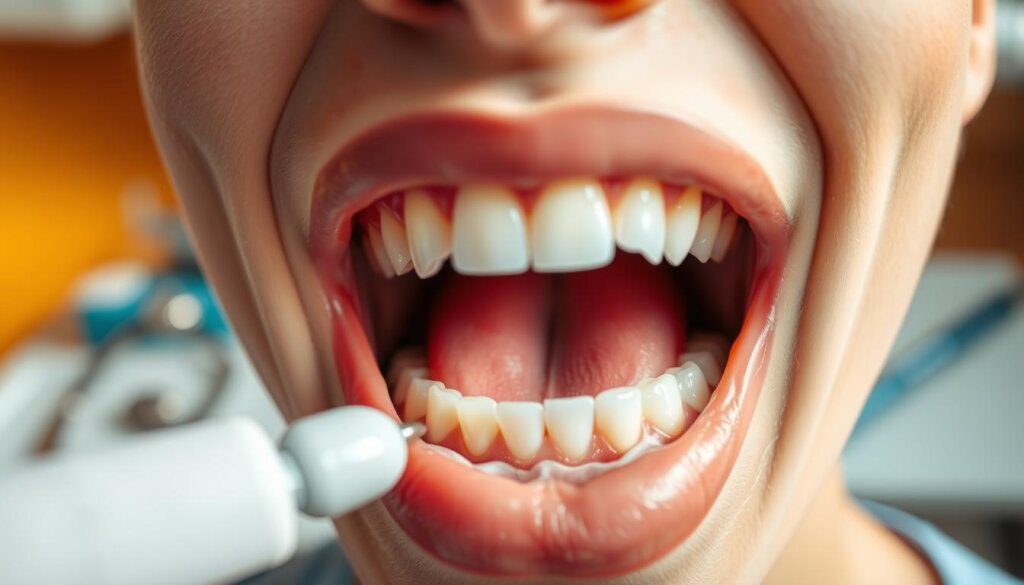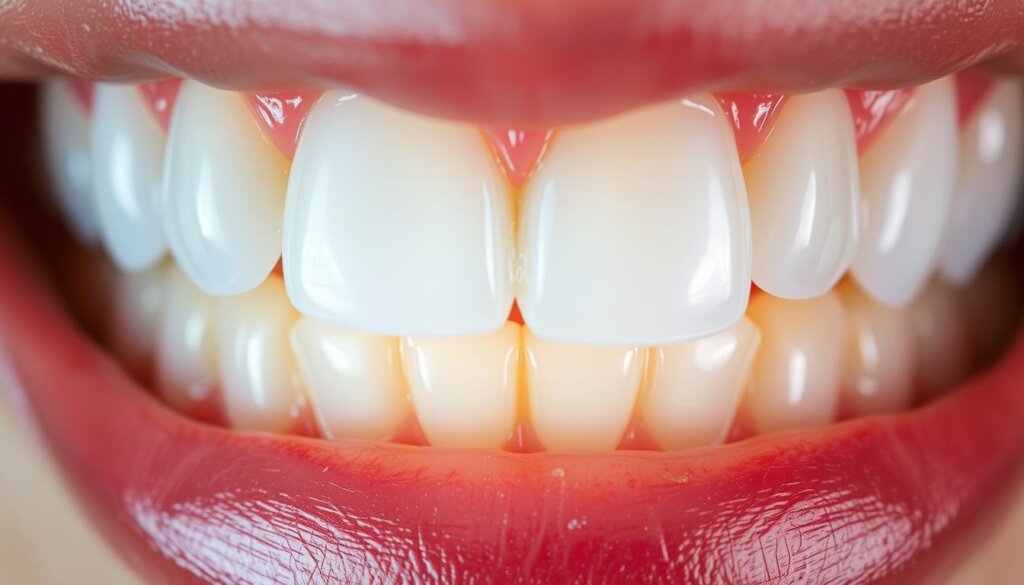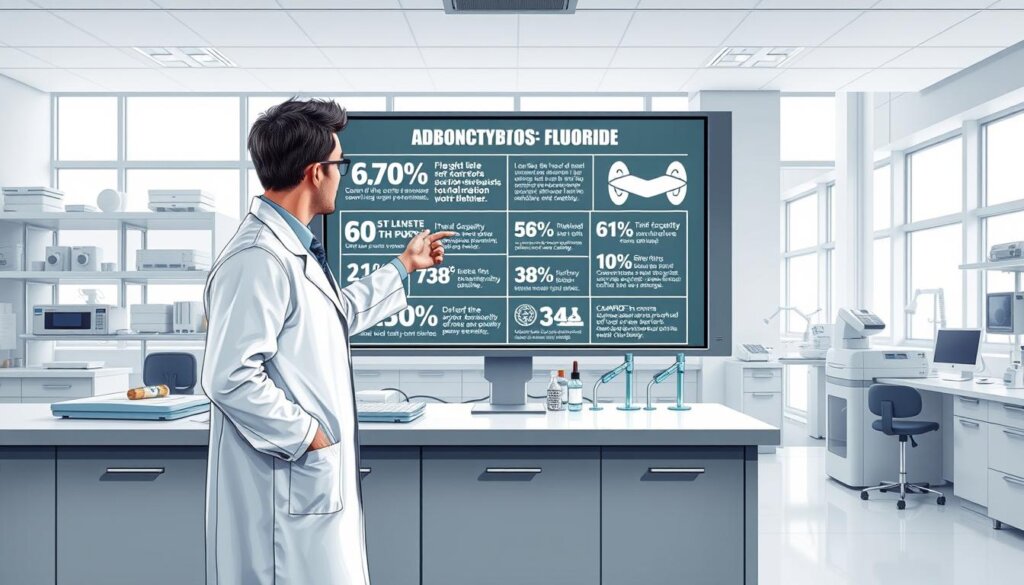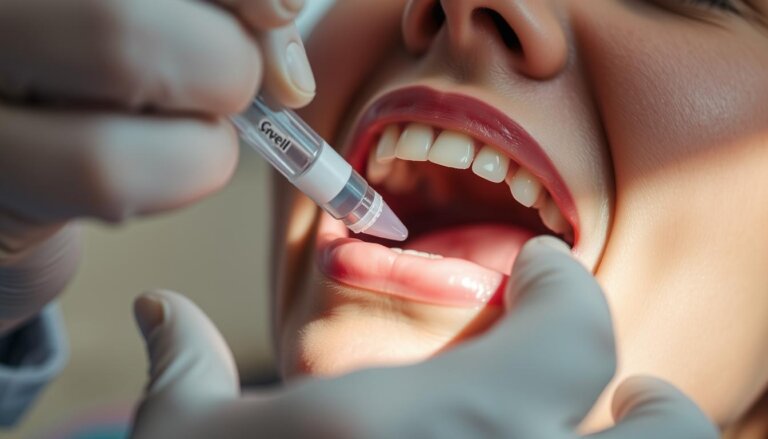Is Fluoride Treatment During Cleaning Necessary?
Most toothpaste you see contains about 95% fluoride. This shows how important it is for keeping teeth healthy. Many people wonder if they need fluoride treatments when they get their teeth cleaned professionally. Fluoride is great for stopping cavities and making the outer layer of your teeth stronger. So, using fluoride during a cleaning might help keep your smile looking good for a long time.
Getting fluoride treatment isn’t just a good idea for healthy teeth. It’s also something many dental experts agree on. When you go for a regular dental check-up, getting a fluoride treatment can help protect your teeth. It’s important to know how fluoride works and when you should use it.
Key Takeaways
- 95% of toothpaste contains fluoride, underscoring its widespread use for cavity prevention.
- Fluoride treatments can play a decisive role in enamel fortification and decay deterrence.
- A professional consensus highlights the necessity of fluoride treatment during dental cleanings.
- The mineral’s preventive benefits are crucial, despite its commonality in over-the-counter dental products.
- Exploration of fluoride therapy for oral health encompasses its scientific basis and practical implications.
Understanding Fluoride in Dentistry
Fluoride is key in keeping teeth healthy. It fights tooth decay and boosts oral health in big ways. It works by stopping decay and even healing early dental caries.
What is Fluoride?
Fluoride, a mineral, is great for teeth. It’s found naturally and added to many dental products. By making enamel stronger, it helps teeth resist decay. This shows the benefits of fluoride treatment.
How Does Fluoride Work?
Fluoride strengthens teeth through a process called remineralization. It repairs enamel by adding minerals like calcium and phosphate. This repair also makes enamel more resistant to bacteria, explaining how does fluoride prevent tooth decay.
Different Types of Fluoride Treatments
Dentists use different fluoride treatments for best results. They include varnish, gels, and foams. Each is applied to teeth, giving a strong dose of fluoride. This is known as fluoride application in dentistry.
- Varnishes: Easily applied, adherent, and contain a high fluoride concentration.
- Gels: Used in professional dental trays for more comprehensive coverage.
- Foams: Often utilized during routine cleanings due to their quick application.
Knowing about these treatments helps everyone see fluoride’s importance. It keeps teeth healthy and prevents future problems.
The Role of Fluoride in Oral Health
The importance of fluoride in dental care is huge for people of all ages. It has solid scientific support and is recommended by dentists. It helps keep our mouths healthy and our teeth strong.
Benefits of Fluoride for Adults
Adults see big benefits from fluoride. It helps with many mouth issues that come with getting older. It’s especially good for:
- Protecting enamel from decay and erosion, thereby reducing the risk of cavities.
- Counteracting the effects of dry mouth, a common side effect of many medications and a condition often exacerbated during menopause.
- Reinforcing the tooth’s defense against the daily assault of bacteria and sugars in the diet.
Benefits of Fluoride for Children
Fluoride is very important for kids in their tooth-growing years:
- Fluoride supports the growth of strong, healthy teeth by creating a robust outer surface that is more resistant to bacterial acid attacks.
- It provides a protective barrier for the young enamel of children, helping guard against the premature decay that affects many pediatric dental patients.
- Regular fluoride treatments can be a preventive tool that saves children from extensive dental treatments in the future.
Overall, fluoride’s role in dental care is key for good dental health through all stages of life. Making fluoride treatments part of regular dental visits can help everyone have healthier mouths.
Fluoride Treatments: What to Expect
When thinking about getting a fluoride treatment, people often ask about the fluoride treatment process and how long the effects last. A typical session is quick, aimed at improving dental health without taking much time.
The fluoride treatment process follows a set yet flexible method. First, the dentist cleans the teeth to clear any plaque or dirt. This ensures the fluoride can fully reach the tooth enamel. Then, they apply a fluoride varnish, gel, or foam. This sits on the teeth for several minutes to soak in properly and protect them.
Knowing how long the benefits of fluoride treatments last is key. The effects can last for months but depend on various things like saliva, what you eat, and how well you clean your teeth. Dentists might suggest more treatments over time to keep teeth healthy.
| Factor | Influence on Fluoride Longevity |
|---|---|
| Saliva Production | Higher saliva production can dilute the fluoride faster, potentially reducing its longevity. |
| Dietary Habits | High sugar and starch intake can necessitate more frequent fluoride treatments. |
| Oral Hygiene | Regular brushing and flossing help extend the effects by preventing plaque buildup. |
| Risk Factors for Decay | Patients with higher decay risk may benefit from more frequent fluoride applications. |
Dentists tailor fluoride treatments to individual needs to keep your teeth healthy.
Indications for Fluoride Treatment
Fluoride treatment is crucial in dental care, especially for those at high risk of dental decay. It helps individuals with pre-existing dental issues too. Figuring out who needs this treatment the most can greatly improve dental health and how we prevent dental problems.
High-Risk Patients
Those who often get cavities or are more prone to tooth decay are key candidates for fluoride treatment. Genetics, diet, and not enough fluoridated water are big risk factors. Fluoride creates a protective layer that fights off plaque and rebuilds tooth enamel.
Those with Existing Dental Issues
For those already facing dental issues, fluoride is very important. It boosts the tooth’s defense against bacteria’s acid attacks. This is crucial for making fillings and crowns last longer and protecting against future decay.
People with conditions like dry mouth also see big benefits from fluoride treatments. Dry mouth can come from certain medicines or medical treatments. It reduces saliva, which usually fights off acid from plaque. So, fluoride is extra helpful for these folks.
Timing of Fluoride Treatments
The timing and frequency of fluoride treatments greatly affect their success. Knowing the optimal timing for fluoride application and fluoride treatment frequency can boost oral health and stop cavities for all risk levels.
We will look into the best times for fluoride use and how often it is suggested based on science and dental advice.
When Should Fluoride Be Applied?
For the best effect, fluoride treatments should be given at key times. The optimal timing for fluoride application depends on things like age, dental history, and lifestyle. Dentists figure out the best timing during check-ups by looking at these factors.
Frequency Recommendations
The fluoride treatment frequency varies by the person’s needs. Usually, high-risk patients need fluoride more often. Here’s a guide to how often different risk groups should get fluoride treatments:
| Risk Category | Recommended Frequency |
|---|---|
| High Risk | Every 3 to 6 months |
| Moderate Risk | Every 6 months |
| Low Risk | Once a year |
This advice helps people get the right fluoride treatments for their dental health. Following these tips helps keep teeth healthy and lowers cavity risks.
Potential Side Effects of Fluoride
Fluoride is known for helping prevent cavities. But, some side effects need attention. These effects are rare but important to understand. This includes issues from both short-term and long-term fluoride use.
Common Reactions: Dental fluorosis is the biggest concern. It causes small changes in tooth enamel. This shows as white streaks on teeth, but only up close. It’s more common in kids who get too much fluoride while their teeth grow.
Long-Term Concerns: Doctors are still looking into fluoride’s long-term effects. Even though studies say dental fluoride is safe, we must watch how much fluoride we use. This helps avoid rare but severe side effects.
This table shows how fluoride affects different ages:
| Age Group | Common Short-Term Side Effects | Potential Long-Term Side Effects |
|---|---|---|
| Children | Mild dental fluorosis | Bone density concerns in extreme cases |
| Adults | Slight tooth discoloration | Enhanced bone fragility if exposed to high fluoride levels constantly |
Knowing about fluoride’s side effects helps. You can keep your teeth healthy by using fluoride carefully. Your dentist can guide you to use fluoride the right way.
Alternatives to Fluoride Treatments
Looking into other options instead of traditional fluoride treatments is important for those wanting a holistic dental care method. There are many natural alternatives to fluoride and non-fluoride dental treatments. These options are good for keeping your teeth healthy.
Natural Remedies
- Herbs like neem and green tea are great for gums and fighting plaque because of their antibacterial powers.
- Eating foods rich in calcium and full of fibers can make your enamel stronger and clean your teeth.
- Xylitol is a natural sugar found in some fruits and used in sugar-free gum. It helps prevent cavities by stopping harmful bacteria from growing.
Other Topical Treatments
| Treatment | Description | Benefits |
|---|---|---|
| Calcium phosphate pastes | Frequent application on the teeth | Helps remineralize enamel and fights erosion |
| Herbal mouthwashes | Alternatives containing essential oils or aloe vera | Enhances gum health without chemicals |
Using these natural alternatives to fluoride and non-fluoride dental treatments in your teeth care routine has great perks. It’s especially good for those who don’t want synthetic stuff in their oral health care.
Fluoride Treatment vs. Routine Cleaning
Discussions on preventive dental care often point out how key both routine cleanings and fluoride treatments are. Understanding their roles helps patients have better oral health.
Routine cleanings are essential. They get rid of plaque and stop tartar from forming. This is the base for good oral health. These cleanings help keep gums healthy and spot dental problems early. Taking these steps early helps avoid big dental issues later on.
Fluoride treatments, however, focus on making teeth stronger, especially the fluoride benefits in dental cleaning. This mineral makes tooth enamel tougher against acid attacks. This is super important for people who get cavities easily or whose enamel is starting to wear away.
Using fluoride makes teeth stronger and protects them from cavities. It’s really important for people who get lots of cavities, have fillings, or have special dental needs.
So, while cleanings keep your mouth clean and healthy, fluoride treatments add extra protection. Taking care of your mouth means combining cleanings with fluoride treatments if you need them. This dual approach is key to preventive dental care.
Myths Surrounding Fluoride Treatment
There are many myths about fluoride treatments that hide their true benefits. By knowing the facts, we understand fluoride’s key role in keeping teeth healthy.
Some people wrongly believe fluoride at dental doses is bad for health. Yet, science shows fluoride’s safety and power in fighting tooth decay, backed by major health groups worldwide.
| Myth | Fact |
|---|---|
| Fluoride is unnatural | Fluoride is a natural mineral found in water and various foods. |
| Fluoride causes harm when used in dental treatments | When used appropriately, fluoride is safe and helps in rebuilding weakened tooth enamel. |
| Using fluoride causes severe health problems | Current research shows that fluoride used at recommended levels does not cause adverse health conditions. |
Let’s dive into fluoride therapy’s effectiveness. Years of study prove fluoride greatly aids in teeth remineralization, cutting down tooth decay risks. This highlights why fluoride is vital in dentistry and public health strategies.
Understanding these truths helps clear up fluoride misconceptions. It underlines the importance of ongoing public education on fluoride benefits. We need to rely on solid scientific evidence and expert insights in dental and public health.
Cost Considerations for Fluoride Treatments
Exploring the fluoride treatment cost and insurance coverage makes a big difference in health choices. Prices change a lot depending on where you go in the U.S. This guide helps you understand these costs for smarter decisions about oral health.
Average Costs in the U.S.
Fluoride treatments can cost from $25 to $55 at different clinics. The price changes based on where the clinic is, the fluoride type, and if it’s with a check-up. Adults should remember that spending on these treatments can save money on bigger dental issues later.
Insurance Coverage
Insurance often pays for kids’ fluoride treatments but not always for adults. Every insurance plan is different. Patients should check their plan for what’s included, like deductibles and limits. If your plan doesn’t cover much, looking into other insurance or discount programs could save money.
- Checking your dental insurance details helps understand fluoride therapy coverage.
- Looking at different insurance plans can help manage dental treatment costs better.
Recommendations from Dental Professionals
Dentists across the country stress the importance of fluoride treatments in daily dental care. They say treatments should be based on personal oral health and risk. This makes sure each person gets the best care to protect and strengthen their teeth.
Leaders of major dental groups agree on certain fluoride use guidelines. These dental association fluoride guidelines help dentists use fluoride wisely. It’s especially important for those with a high chance of getting cavities.
| Association | Recommended Fluoride Treatment | Frequency | Risk Profile |
|---|---|---|---|
| American Dental Association | Topical Fluoride Varnish or Gel | Semi-annually | High Decay Risk |
| World Dental Federation | Fluoride Rinses | Quarterly | Moderate Risk |
| European Dental Council | Fluoride Supplements | As prescribed by dentist | Low to Moderate Risk |
The table shows agreement worldwide on how often and what kind of fluoride treatment is needed. It shows how custom plans based on personal risk assessments are key. This approach is a main point in the dental association fluoride guidelines.
Fluoride Treatment Across Different States
In the U.S., knowing about fluoride usage regulations and state differences in dental fluoride treatments is key. These rules affect how easy it is to get treatments and dental care quality by area. The way each state handles fluoride impacts how well dental health plans work.
It’s important for dentists and patients to understand these state-by-state variations. This ensures treatments work well and follow local laws. We will look at how these differences affect people and doctors in various states.
| State | Fluoridation Requirements | Fluoride Treatment Recommendations |
|---|---|---|
| California | Mandatory in communities >10,000 residents | Highly recommended for all age groups |
| Texas | No state mandate, local discretion advised | Recommended, with focus on high-risk populations |
| New York | Mandatory statewide | Universal recommendations with special pediatric focus |
| Florida | Voluntary, varies widely by county | Advised, especially in areas lacking water fluoridation |
The table shows the state differences in dental fluoride treatments. Some places have strict rules on fluoride use, while others are more flexible. This flexibility helps adapt to local needs and water fluoride levels.
For people living in the U.S., where you live can really influence your fluoride treatment needs. It’s wise to know your state’s fluoride rules for the best dental health.
Conclusion: Is Fluoride Treatment Necessary?
When we talk about oral health, there’s a lot of support for using fluoride, but also some warnings. It’s clear that fluoride plays a key role, but it’s not right for everyone. The benefits, like stronger teeth and fewer cavities, are known, yet how it’s used must be specific to the person.
For those who easily get cavities or are getting dental work done, tailored dental fluoride application is key. This approach is backed by many studies. Working closely with dentists and understanding your dental needs make fluoride safe and essential.
Fluoride is important, but the treatment needs to fit the person. Dentists aim to both use science and meet individual health goals. So, the success of fluoride in improving dental health depends on careful thinking, making smart choices, and balancing science with personal care.







